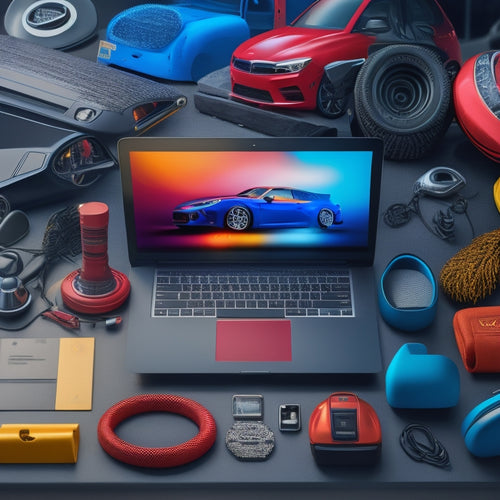
Off-Grid Solar Battery Maintenance Essentials
Share
To guarantee your off-grid solar battery system runs efficiently and reliably, you'll need to prioritize regular maintenance. Start by selecting the right battery type for your specific needs, then monitor system performance to identify potential issues early on. Regularly clean and inspect your batteries, and check electrolyte levels to prevent corrosion and damage. Don't forget to inspect terminals and connections, perform load bank testing, and equalize charging to maintain peak battery health. As you explore deeper into the specifics of your system's maintenance needs, you'll uncover the key to maximizing energy output and prolonging your battery's lifespan.
Key Takeaways
- Accurate monitoring of key performance metrics is essential for identifying potential issues and optimizing system efficiency.
- Regular cleaning and inspection of batteries, terminals, and connections prevent corrosion and ensure proper airflow and energy transfer.
- Watering and electrolyte level maintenance are critical for battery performance, longevity, and system reliability, following manufacturer guidelines.
- Load bank testing and equalization charging help maintain peak battery efficiency by detecting weak cells and redistributing charge evenly among cells.
- Scheduling regular maintenance tasks, such as monitoring state of charge and inspecting electrical connections, extends battery lifespan and ensures optimal performance.
Understanding Solar Battery Types
Your solar power system's performance relies heavily on the batteries, which store excess energy generated by your solar panels during the day for use at night or during power outages.
When selecting batteries for your off-grid solar system, you'll encounter various types, each with its strengths and weaknesses.
Lithium batteries, for instance, boast high energy density and long lifespans, making them ideal for deep-cycle applications.
Lead acid batteries, on the other hand, are more affordable but heavier and less efficient.
Gel batteries and AGM (absorbed glass mat) batteries are variants of lead acid batteries, offering improved reliability and maintenance-free operation.
Nickel cadmium batteries, while less common, provide high discharge rates and long lifespans.
When choosing a battery type, consider factors like solar compatibility, charging cycles, and battery lifespan.
Understanding these differences will help you make an informed decision, ensuring your off-grid solar system operates efficiently and reliably.
Monitoring System Performance
The performance of your off-grid solar power system relies heavily on accurate monitoring, as it enables you to identify potential issues before they escalate into major problems.
By tracking key performance metrics, you'll be able to optimize your system's efficiency and troubleshoot any faults that may arise. You'll need to invest in reliable monitoring tools that can provide real-time data on your system's energy production, consumption, and storage.
This will help you identify trends, patterns, and anomalies in your system's behavior, allowing you to make informed decisions about maintenance and upgrades.
Some essential performance metrics to track include energy output, charge/discharge cycles, and battery state of charge.
Cleaning and Inspection
Regular monitoring helps identify potential issues, but it's equally important to perform routine cleaning and inspections to guarantee your off-grid solar power system operates at peak performance.
Cleaning your batteries is essential to prevent corrosion and maintain proper airflow. You'll need the right cleaning tools, including a soft-bristled brush, distilled water, and a mild detergent. Remember to take necessary safety precautions, such as wearing gloves and protective eyewear.
Here is a checklist for your cleaning and inspection routine:
| Component | Inspection Frequency | Action |
|---|---|---|
| Terminals | Monthly | Clean corrosion and maintain secure connections |
| Battery Top | Quarterly | Remove debris and dust, maintaining proper airflow |
| Cables and Connectors | Semiannually | Inspect for signs of wear or damage, replacing as needed |
Remember to always refer to your battery manufacturer's guidelines for specific cleaning and inspection recommendations. By following these steps, you'll guarantee your off-grid solar power system operates at maximum efficiency and prolongs the lifespan of your batteries.
Watering and Electrolyte Levels
Properly maintaining water and electrolyte levels in your off-grid solar batteries is crucial to their performance, longevity, and overall system reliability. You must regularly check the electrolyte levels to verify they're within the recommended range.
For flooded batteries, you'll need to perform battery watering to maintain the ideal level. Make certain to use distilled or deionized water to avoid contaminating the electrolyte.
When checking the electrolyte levels, look for signs of overwatering or under-watering. Overwatering can cause the electrolyte to spill over, while under-watering can lead to permanent damage. You should also inspect the battery for signs of electrolyte leakage or corrosion.
During electrolyte maintenance, you'll need to add the recommended type and amount of electrolyte to the battery. Always follow the manufacturer's instructions for electrolyte maintenance to verify you're using the correct procedure.
Terminal and Connection Checks
Every three to six months, you should inspect your off-grid solar battery terminals and connections to verify they're clean, tight, and free of corrosion. This is vital to guarantee connection integrity and prevent terminal corrosion, which can lead to reduced battery performance, efficiency, and lifespan.
| Inspection Point | Action |
|---|---|
| Terminals | Clean with a wire brush, and apply a thin layer of silicone-based grease to prevent corrosion. |
| Connection Bolts | Check for tightness and re-torque if necessary. |
| Cable Connectors | Inspect for signs of wear, corrosion, or damage, and replace if necessary. |
When inspecting your terminals and connections, look for signs of corrosion, such as green or white powder, or rust. Remove any corrosion you find, and reapply grease or replace components as needed. Remember, a clean and tight connection is fundamental for efficient energy transfer and to prevent damage to your off-grid solar battery system.
Load Bank Testing
You'll use load bank testing to determine your battery's capacity, which involves applying a controlled load to the battery bank to simulate real-world usage.
This process helps you identify weak cells that may be underperforming, allowing you to take corrective action.
Test Battery Capacity
When sizing up your off-grid solar battery's capacity, load bank testing is an important step in determining its ability to meet your energy needs. This process involves connecting a load bank to your battery, which simulates real-world energy demands. By doing so, you'll get a clear depiction of your battery's capacity, helping you identify potential issues before they become major problems.
Load bank testing is particularly vital as your battery ages. Battery aging can lead to capacity loss, reducing your system's overall performance. Regular capacity testing guarantees you're aware of any declines in capacity, allowing you to take corrective action.
| Test Result | Action |
|---|---|
| Capacity meets expectations | Continue monitoring and maintenance schedule |
| Capacity is below expectations | Perform additional testing to identify weak cells |
| Capacity is markedly below expectations | Consider replacing the battery or adding additional capacity |
Identify Weak Cells
What's behind a battery's subpar performance? Often, it's a weak cell or cells that are the culprits. Identifying these cells is essential to maintaining your off-grid solar battery's ideal performance.
Load bank testing is an effective method to detect weak cells. This test simulates real-world usage by applying a controlled load to the battery bank. By monitoring cell voltage and current during the test, you can pinpoint cells that are underperforming.
Thermal imaging can also be used to identify hotspots, which may indicate weak cells. During load bank testing, thermal imaging cameras capture temperature variations across the battery bank, helping you visualize which cells are generating excessive heat.
This data, combined with cell voltage readings, provides a thorough overview of your battery's health.
Prevent Faulty Readings
To guarantee accurate results from load bank testing, it is crucial to prevent faulty readings that can mislead your assessment of the battery's health. Faulty sensors or incorrect calibration techniques can lead to inaccurate data, which can have serious consequences for your off-grid solar system.
To guarantee reliable data, you should:
| Preventative Measure | Description |
|---|---|
| Regularly inspect sensors | Check for signs of physical damage, corrosion, or wear that could affect sensor accuracy |
| Calibrate sensors correctly | Use recommended calibration techniques to guarantee sensors are accurately measuring battery performance |
| Perform routine maintenance | Regularly clean and maintain the load bank testing equipment to prevent malfunctions |
Equalization Charging
You'll need to perform equalization charging periodically to maintain your off-grid solar battery's health and extend its lifespan.
This process involves overcharging the battery to redistribute the charge evenly among its cells, which helps prevent stratification and sulfation.
When to Equalize
Equalization charging is an important maintenance task that helps prevent sulfation and guarantees your off-grid solar battery bank operates at peak efficiency. It's vital to understand when to equalize your batteries to maintain their health and extend their lifespan.
The frequency of equalization charging depends on various factors, including the type of batteries, operating conditions, and charging frequency. As a general rule, you should equalize your batteries every 1-3 months, depending on the depth of discharge (DOD). If you're using a deep cycle battery with a high DOD, you may need to equalize more frequently.
Here's a general guideline for equalization charging frequency:
| Depth of Discharge (DOD) | Equalization Frequency |
|---|---|
| 20-50% | Every 3 months |
| 50-80% | Every 1-2 months |
| >80% | Every 1 month |
How It Works
Most off-grid solar systems rely on a sophisticated charging process to maintain their batteries' health, and equalization charging is a vital aspect of this process.
You're probably wondering how it works. In brief, equalization charging is a controlled overcharge of your deep cycle batteries. This process guarantees that all cells in the battery bank are at the same state of charge, which is essential for maintaining your battery lifespan.
When you equalize your batteries, the solar energy system's charge controller temporarily increases the voltage above the normal absorption voltage. This forces the batteries to accept a higher charge, which helps to desulfate the plates and remove any sulfate buildup.
As a result, the cells become balanced, and the overall battery health improves. By doing so, you'll reduce the risk of premature battery failure and guarantee your off-grid solar system operates at its best.
Battery Balancing Techniques
Your off-grid solar battery bank's overall health and performance rely heavily on its individual cells being in sync. When cells are balanced, they work together efficiently, providing the maximum amount of power to your off-grid system.
Imbalanced cells, on the other hand, can lead to reduced performance, overheating, and even premature failure. To guarantee your battery bank operates at its best, you need to employ effective battery balancing techniques.
There are several battery balancing methods you can use, including:
-
Active balancing: This method uses specialized balancing equipment to actively regulate the charge and discharge of each cell, ensuring they remain in sync.
-
Passive balancing: This approach uses resistors to dissipate excess energy from cells that are overcharged, preventing them from getting too far ahead of the others.
-
Cell monitoring and tracking: This method involves regularly monitoring the state of charge, voltage, and temperature of each cell, allowing you to identify and address any imbalances before they become a problem.
Avoiding Deep Discharging
While maintaining balance among your off-grid solar battery bank's cells is vital, another important aspect to focus on is avoiding deep discharging.
Deep discharging occurs when your batteries are drained below 50% of their capacity, which can greatly reduce their lifespan. Each time you deeply discharge your batteries, you're reducing the number of discharge cycles they can handle. This can lead to a shorter battery lifespan, which means you'll need to replace them more frequently.
To avoid deep discharging, you should monitor your battery state of charge (SOC) regularly. You can do this using a battery monitor or a solar charge controller with a built-in monitor.
Set a low voltage disconnect (LVD) to prevent over-discharging. When the SOC reaches a certain threshold, the LVD will disconnect the load, preventing further discharge.
You can also adjust your energy usage habits to avoid deep discharging. By keeping your batteries between 20% and 80% SOC, you'll maximize their lifespan and guarantee they provide reliable power for years to come.
Scheduling Regular Maintenance
Regular maintenance is essential to guarantee your off-grid solar battery bank operates at peak performance and extends its lifespan.
To make certain you stay on top of maintenance tasks, create a schedule that works for you. This can be a monthly, quarterly, or seasonal checklist, depending on your specific needs and climate.
Here are three essential items to include in your maintenance checklist:
-
Battery state of charge monitoring: Regularly check your batteries' state of charge to make certain they're not over- or under-charged. This helps prevent damage and prolongs their lifespan.
-
Electrical connection inspection: Verify that all electrical connections are clean, tight, and free of corrosion. Loose connections can lead to system failures and even fires.
-
Seasonal notifications: Set notifications to perform tasks specific to each season, such as cleaning your solar panels in spring or checking your battery watering system in summer.
Frequently Asked Questions
Can I Mix Old and New Solar Batteries in My Off-Grid System?
Surprise, you're not a mad scientist, so don't mix old and new solar batteries! You'll compromise battery compatibility, reducing charging efficiency, and ultimately, your system's overall performance. You're better off investing in a uniform battery bank to guarantee ideal power output.
How Often Should I Replace My Solar Battery Maintenance Log?
You should replace your solar battery maintenance log every 6-12 months, as it helps track battery lifespan and guarantees you're meeting the recommended maintenance frequency, thereby prolonging your batteries' health and overall system performance.
Are There Any Specific Tools Required for Solar Battery Maintenance?
You'll need a multimeter for voltage and state-of-charge readings, as well as a hydrometer for specific gravity checks; additionally, consider investing in a battery tester to guarantee accurate battery testing and inform your maintenance frequency.
Can I Perform Solar Battery Maintenance on a Cloudy Day?
You can perform solar battery maintenance on a cloudy day, but be aware that reduced solar input may impact solar battery performance; consider cloudy day considerations, like decreased charging capacity, to guarantee ideal maintenance and battery health.
Do I Need to Wear Protective Gear During Solar Battery Maintenance?
When performing solar battery maintenance, you should always wear protective gear, including gloves and safety glasses, to guarantee your safety and prevent electrical shock, which is essential for maintaining ideal battery health and preventing long-term damage.
Related Posts
-

10 Essential Bike Lane Safety Features to Consider
You're designing a bike lane with safety in mind, and that's essential. The National Highway Traffic Safety Administr...
-

Top 10 Tips for Buying Car Accessories Online
When purchasing car accessories online, you should take proactive steps to avoid low-quality or incompatible products...
-

10 Tips for Cleaner City Air With Scooters
By adopting a few simple habits, you can make a significant impact on reducing city air pollution with your scooter. ...


